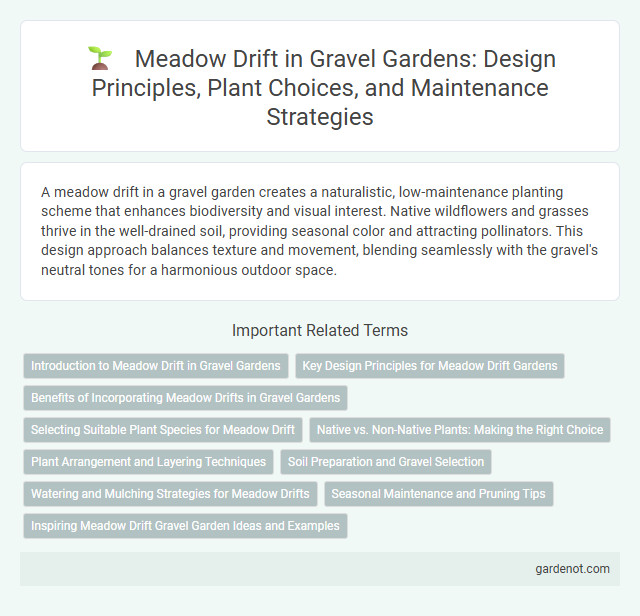A meadow drift in a gravel garden creates a naturalistic, low-maintenance planting scheme that enhances biodiversity and visual interest. Native wildflowers and grasses thrive in the well-drained soil, providing seasonal color and attracting pollinators. This design approach balances texture and movement, blending seamlessly with the gravel's neutral tones for a harmonious outdoor space.
Introduction to Meadow Drift in Gravel Gardens
Meadow Drift in gravel gardens combines the natural beauty of meadow plants with the structured texture of gravel, creating a sustainable and low-maintenance landscape. This planting style emphasizes drought-tolerant grasses and wildflowers that thrive in well-drained gravel substrates, promoting biodiversity. Incorporating Meadow Drift enhances visual interest through seasonal changes and supports pollinators by providing continuous nectar sources.
Key Design Principles for Meadow Drift Gardens
Meadow drift gardens prioritize naturalistic planting schemes that mimic wild meadows, using a blend of native grasses and wildflowers for seasonal interest and ecological benefits. Design emphasizes layered planting to create fluid transitions between plant species, enhancing biodiversity and supporting pollinators. Proper spacing and color harmony guide visual flow while ensuring sustainable growth and minimal maintenance.
Benefits of Incorporating Meadow Drifts in Gravel Gardens
Meadow drifts in gravel gardens enhance biodiversity by attracting pollinators such as bees and butterflies, promoting a healthy ecosystem. These drifts improve soil health through natural nutrient cycling and moisture retention, reducing the need for irrigation and fertilizers. Their vibrant, natural aesthetics provide year-round visual interest and create a seamless transition between designed garden spaces and surrounding landscapes.
Selecting Suitable Plant Species for Meadow Drift
Selecting suitable plant species for a meadow drift involves choosing native wildflowers and grasses that thrive in local soil and climate conditions, ensuring ecological harmony and minimal maintenance. Emphasizing drought-tolerant and pollinator-friendly plants like black-eyed Susans, coneflowers, and switchgrass enhances biodiversity and supports local wildlife. Proper species selection also promotes seasonal interest and natural resilience, creating a sustainable and visually appealing gravel garden meadow drift.
Native vs. Non-Native Plants: Making the Right Choice
Choosing native plants for a gravel garden's meadow drift promotes local biodiversity, supports pollinators, and requires less maintenance due to their adaptation to regional soil and climate. Non-native plants may offer aesthetic variety but risk becoming invasive, disrupting ecosystems and outcompeting indigenous species. Prioritizing native flora ensures ecological balance and sustainable garden health over time.
Plant Arrangement and Layering Techniques
Meadow drift in gravel gardens employs strategic plant arrangement and layering techniques to create dynamic visual interest and biodiversity. Tall grasses and flowering perennials are positioned in tiers, with lower groundcovers nestled beneath mid-height blooms, ensuring continuous seasonal texture and color contrast. This layered planting approach enhances soil stability and supports pollinators, contributing to a resilient and sustainable garden ecosystem.
Soil Preparation and Gravel Selection
Meadow drift in a gravel garden requires well-drained soil achieved by incorporating coarse sand and organic matter to enhance aeration and moisture retention. Selecting angular gravel with particle sizes ranging from 8 to 16 mm ensures optimal drainage while supporting native meadow plants' root systems. Proper soil preparation combined with carefully chosen gravel creates a stable substrate that promotes healthy plant growth and reduces waterlogging.
Watering and Mulching Strategies for Meadow Drifts
Effective watering strategies for meadow drifts emphasize deep, infrequent irrigation to encourage strong root development and drought resilience. Mulching with organic materials like straw or shredded bark helps retain soil moisture, reduces weed growth, and improves soil structure over time. Combining these methods supports healthy plant establishment and sustainable maintenance of vibrant meadow drifts.
Seasonal Maintenance and Pruning Tips
Meadow drift in a gravel garden requires seasonal maintenance to ensure plant health and aesthetic appeal, including cutting back perennials in late autumn to prevent disease and promote vigorous spring growth. Pruning should be done selectively in early spring to remove dead or damaged stems while preserving seed heads for winter interest and wildlife support. Regular removal of invasive weeds and light mowing helps maintain clear paths and supports desired plant diversity within the meadow drift.
Inspiring Meadow Drift Gravel Garden Ideas and Examples
Meadow drift gravel gardens create a naturalistic landscape by blending soft gravel pathways with clusters of native wildflowers and ornamental grasses, enhancing biodiversity and visual texture. Incorporating drought-tolerant perennials like echinacea, coneflowers, and blue fescue ensures sustainability and low maintenance while attracting pollinators such as bees and butterflies. This combination of gravel and meadow plants offers a serene, eco-friendly garden design ideal for creating tranquil outdoor spaces with year-round interest.
Meadow drift Infographic

 gardenot.com
gardenot.com